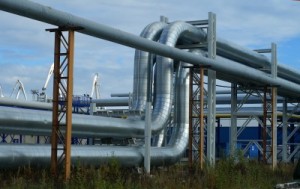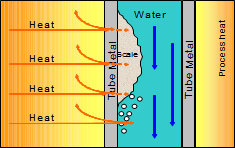The capacity of a given steam boiler system to generate steam is influenced by many factors.

One of the primary factors is the rate of heat transfer from the combustion side of the boiler tube into the water on the other side of the tube wall. If this rate is reduced, then the heat will pass through the tubes before it can be transferred to the water to generate steam. The energy is then lost as hotter flue gasses to the atmosphere.
If scale deposits are present on the tube, these can greatly reduce rate of heat transfer. This is depicted in Figure 1 below. In addition table 1 below shows the rate of heat transfer of boiler steel compared to common scale deposits.

Figure 1 - Heat Transfer Path
| Table 1 Thermal Conductivities | |
|---|---|
| Heat Exchanger Materials | Thermal Conductivity (K) |
| Tube Steel | 310 |
| Insulating Brick | 0.7 |
| Scales | |
| Calcium Carbonate | 16 |
| Calcium Silicate | 8 |
| Calcium Sulphate | 16 |
| Magnesium Phosphate | 15 |
| Silicate Scale, Porous | 0.6 |
| Sludges | |
| Calcium Hydroxyapatite | 18 |
| Serpentine | 17 |
| Iron Oxide | |
| Magnetic Iron Oxide | 20 |
ZI-CHEM® chemical program technologies offer an extensive range of advanced efficiency management systems, to ensure effective control of scale deposition is achieved to ensure heat transfer capacity is maximized. This begins with computer modelling of actual vs design, through to extensive program design and implementation including: